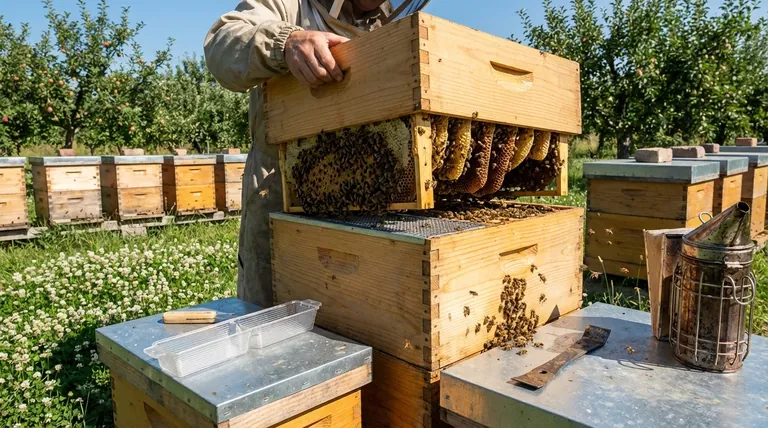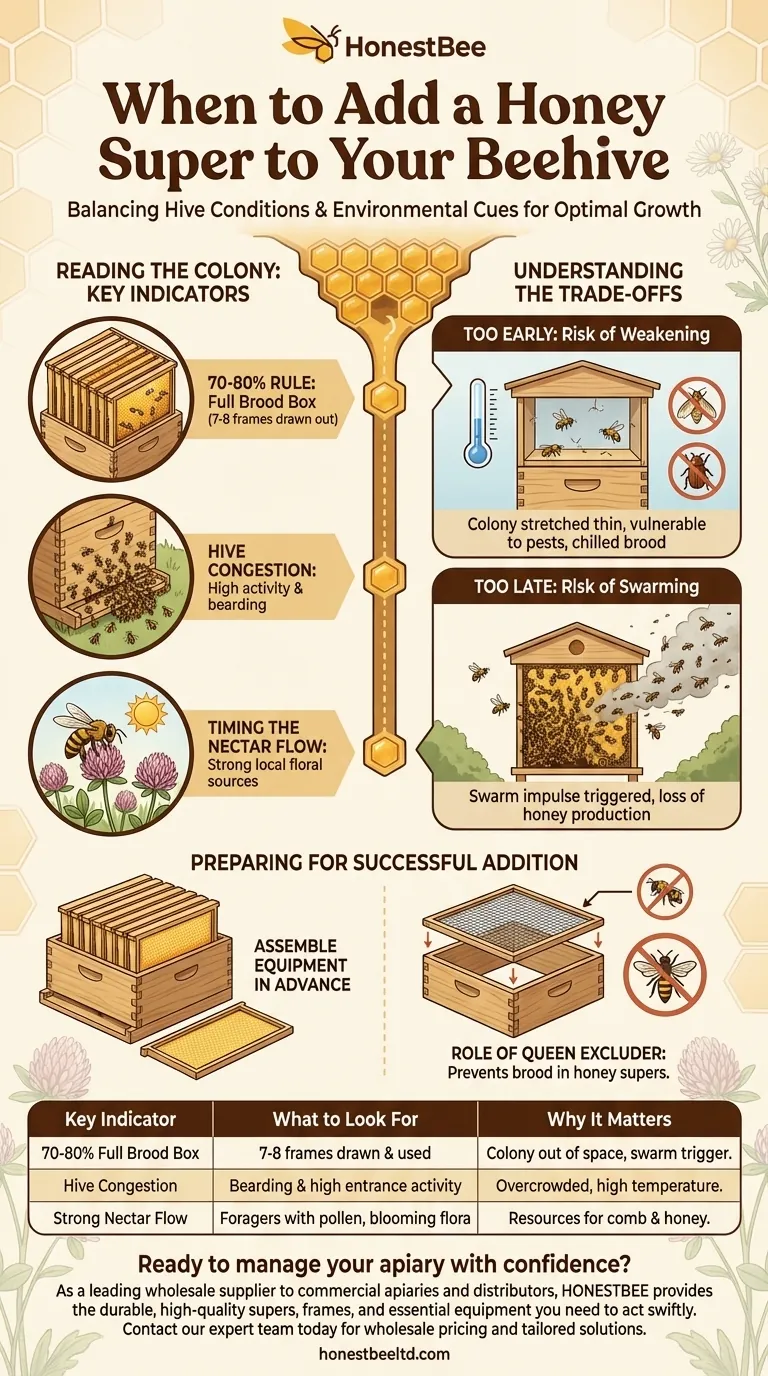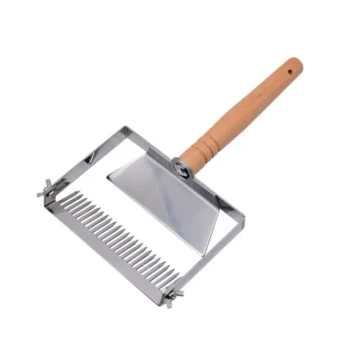The right time to add a honey super is signaled by a combination of internal hive conditions and external environmental cues. The most reliable signs are when the uppermost brood box is 70-80% full of bees, brood, and resources, and the bees are actively bringing in nectar. Observing this prevents the colony from becoming overcrowded, which is a primary trigger for swarming.
Your goal is not just to give bees more room, but to provide that room at the precise moment they need it. Adding a super is a proactive measure to manage your colony's natural impulse to expand, preventing swarming and maximizing honey storage.

Reading the Colony: Key Indicators for Expansion
The decision to add a super is based on direct observation. You must look for clear signals that the colony is running out of space and has the resources to expand.
The 70-80% Rule: Inspecting Brood Frames
The most definitive internal sign is the state of your top brood box. A standard hive box contains 8 or 10 frames.
When seven or eight of these frames are "drawn out" with wax comb and actively used by the bees for raising brood, storing pollen, or storing nectar, the box is considered full. This is the clearest indicator that space is becoming a premium.
Observing Hive Congestion
A crowded hive will show external signs of its internal state. Look for an unusually high amount of bee activity at the hive entrance.
You may see bees "bearding," where a large number of bees cluster on the outside of the hive, especially in the evening. This behavior indicates there isn't enough room inside and that the internal temperature is high due to the density of the bee population.
Timing the Nectar Flow
Bees only build comb and store excess honey when there are abundant resources available. The presence of a strong nectar flow is the environmental trigger for this activity.
Observe your local environment. When you see major floral sources like clover, fruit trees, or blackberries in full bloom and notice foragers returning to the hive with full pollen baskets, the nectar flow has begun. Adding a super just as this starts gives them a dedicated space to store the incoming bounty.
Understanding the Trade-offs of Timing
Timing is a balance. Acting too early or too late both come with distinct consequences for the health and productivity of your colony.
The Risk of Adding a Super Too Early
Giving a colony too much space before they are ready can weaken them. The bees must patrol, defend, and thermoregulate the entire hive cavity.
Adding a super prematurely creates a large, empty space that the existing population cannot adequately manage. This stretches the colony's resources thin, making them more vulnerable to pests like wax moths and small hive beetles, and can chill the brood nest during cool nights.
The Consequence of Adding a Super Too Late
Waiting too long is the most common and critical mistake. A crowded hive with a strong nectar flow will quickly trigger the swarm impulse.
When the queen runs out of cells to lay eggs in because the bees have started storing nectar in the brood nest (a behavior known as "backfilling"), the colony will begin preparations to swarm. They will raise new queen cells and the old queen will leave with up to half the workforce. Adding a super too late means you have likely missed the window to prevent a swarm and lost a significant portion of your honey-producing population.
Preparing for a Successful Addition
Once you see the signs, you must be ready to act. Having your equipment prepared is as important as recognizing the timing.
Assembling Your Equipment in Advance
Do not wait until the day of your hive inspection to build your equipment. Have your super, frames, and foundation fully assembled and ready to go. A strong nectar flow can cause a hive to fill up in a matter of days, and any delay can lead to swarming.
The Role of the Queen Excluder
A queen excluder is a screen that is placed between the brood boxes and the honey supers. The openings are large enough for worker bees to pass through but too small for the larger queen.
Using an excluder ensures the queen cannot lay eggs in the honey supers. This keeps the honey harvest free of brood and makes the extraction process cleaner. It dedicates the new space exclusively for honey storage.
Making the Right Choice for Your Hive
Apply these principles based on your specific goals for the colony.
- If your primary focus is preventing a swarm: Add the super as soon as you see the top brood box is 70-80% full, especially if a strong nectar flow is imminent.
- If your primary focus is maximizing honey production: Add the super just as the main nectar flow begins to ensure bees immediately use the new space for honey, not for brood.
- If you are managing a new or weaker colony: Be more conservative and wait until the hive is undeniably strong and packed with bees to avoid stressing them with too much space.
Proper timing is the key to working in partnership with your colony's natural instincts for growth.
Summary Table:
| Key Indicator | What to Look For | Why It Matters |
|---|---|---|
| 70-80% Full Brood Box | 7-8 frames drawn out with comb and actively used. | Colony is out of space; primary trigger for swarming. |
| Hive Congestion | Bearding (bees clustering outside) and high entrance activity. | Internal hive is overcrowded and temperature is high. |
| Strong Nectar Flow | Foragers returning with full pollen baskets; local flora in bloom. | Bees have resources to build comb and store excess honey. |
Ready to manage your apiary with confidence?
As a leading wholesale supplier to commercial apiaries and distributors, HONESTBEE provides the durable, high-quality supers, frames, and essential equipment you need to act swiftly when your hives signal for expansion. Our bulk-focused operations ensure you get the reliable gear required for proactive hive management, helping you prevent swarming and maximize honey production.
Let's discuss your apiary's needs — Contact our expert team today for wholesale pricing and tailored solutions.
Visual Guide

Related Products
- In-Hive Dual Compartment Frame Bee Feeder for Targeted Colony Nutrition
- HONESTBEE Professional Entrance Bee Feeder Hive Nutrition Solution
- Wooden Bee Brush with Double-Row Horsehair Bristles
- High-Efficiency Diamond Maze Bee Escape for Clearing Supers
- Plastic Handle Single Row Artificial Fiber Bee Brush
People Also Ask
- What are division board feeders? Essential Tools for Safe and Effective In-Hive Feeding
- How do you feed bees outside the hive? Understanding the Risks and Safe Alternatives
- Are frame feeders good? Maximize Your Hive's Health with the Right Feeding Strategy
- How does the internal feeder method work? Protect Your Hive from Robbing and Cold
- What are frame feeders, and what are their advantages? Essential for Cold Weather & Efficient Feeding



















